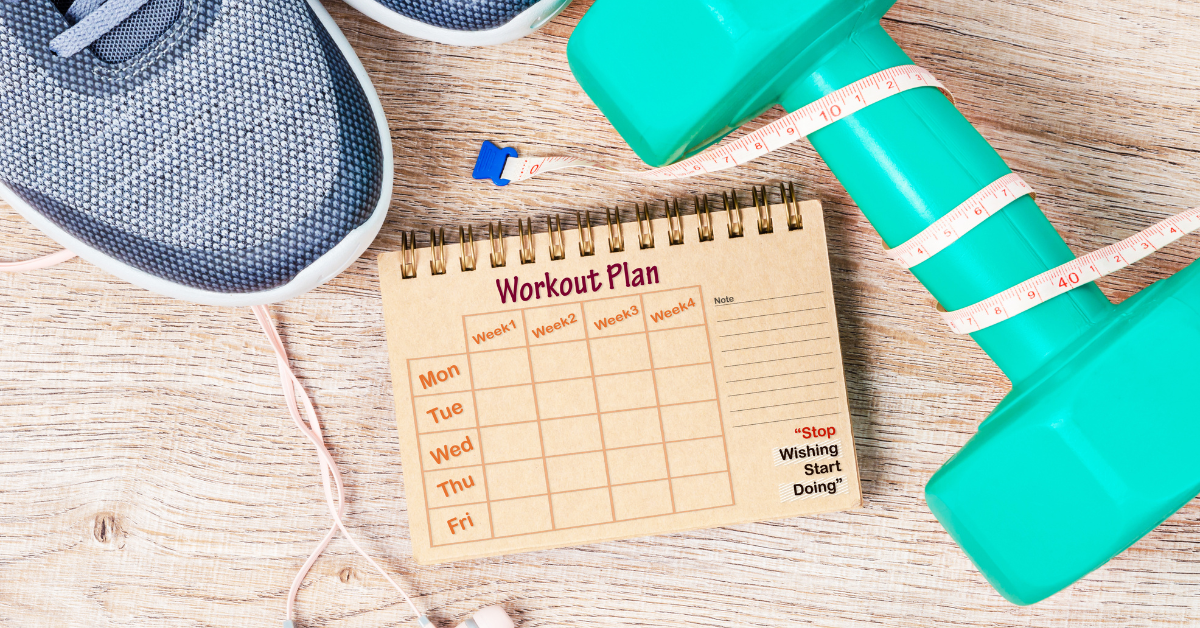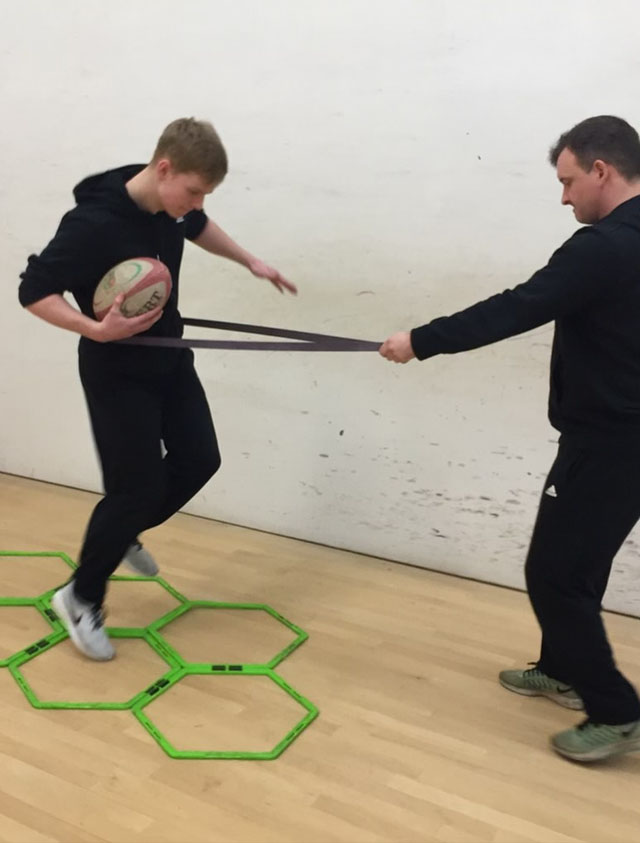Are you looking for a new way to break free from a stagnant, slow-paced fitness routine? With our seven simple steps, we’ll show you how to create an effective routine that will help you reach your fitness goals in no time. Whether you want to tone up, bulk up, or simply stay healthy, we’ll give you the tools and information to make it happen. Therefore, without further ado, let’s dive into the seven steps of creating an effective fitness routine, incorporating activities like a brisk walk or incorporating a new muscle group into your workout routine.
Quick Explanation of Key Points
Start by creating a goal for yourself to work towards and add small, attainable steps to reach it. Make sure the routine is something you will enjoy so you stay motivated, and consult with your doctor or a fitness professional if needed. Don’t neglect your legs, as working on this muscle group can lead to improved overall fitness level, and remember that combining different exercises, including ones that strengthen your front, can be helpful.

Setting Goals for Fitness
When it comes to creating a successful fitness routine, it is important to set clear, achievable goals for yourself. For some, these goals might be short-term and focused on the immediate future. These goals could include running a certain distance, achieving a certain number of repetitions at the gym, or building a certain amount of muscle over the course of a few weeks. Others may have more ambitious long-term goals in mind such as losing a significant amount of weight in a defined period of time or competing in a specific kind of race or event.
No matter what you ultimately choose as your personal fitness goal, it is important to create a plan and break your goal down into smaller measurable milestones on your way to achieving it. In doing so, you can better track and monitor your progress along the way. You will also be able to recognise and savour any successes you make along the journey. While setting ambitious and challenging goals is an important part of self-improvement, having realistic expectations enables one to stay focused and motivated while pursuing their fitness dreams.
Having solid and attainable targets in mind not only helps to keep you on track but also provides much-needed motivation along the way. As determination is often just as important as ambition for completing any task, it is essential to develop a plan which allows you to stick with it no matter what challenges are waiting ahead. Now that we have discussed the importance of goal setting for an effective fitness routine, let’s transition our focus to looking at strategies for staying motivated and determined over time.
- Regular aerobic exercise such as brisk walking, jogging, swimming and cycling can help reduce the risk of chronic health conditions, like heart disease.
- Studies show that resistance training (i.e. lifting weights) is effective in improving muscle strength, muscle endurance and reducing body fat percentage.
- Research demonstrates that combining aerobic and resistance training in an overall fitness routine produces better health outcomes than either alone.
Determination and Motivation
In order to be successful in creating an effective fitness routine and achieving goals, it is imperative to have determination and motivation. If a person has a clear goal that they are determined to reach, no matter how challenging it may be, they will most likely achieve it with the right motivation. Having realistic expectations of oneself and setting smaller goals along the way can help maintain focus and make the larger goal more achievable. For maximum effectiveness, having both a long-term reason for the goal and daily reasons that inspire the person to stick with their regimen are important.
When attempting to find inspiration, it can help to think about why one wants to reach a certain goal. Think about how reaching the goal will improve someone’s life or how it will help remedy a problem or situation. Similarly, connecting what is being done now to future outcomes can help keep someone motivated over time. For example, incorporating a daily walk as part of your workout routine might seem like a small step, but it could lead to achieving greater fitness levels and overall health in the long run.It could also be useful for someone to break down an intimidatingly large task into manageable tasks that are accessible in terms of time and effort. Additionally, seeing tangible evidence of progress towards a goal can provide major boosts in confidence and motivation as well as renew energy when things begin flagging after pursuing something for a while. This strategy can be especially helpful when aiming to improve heart rate, muscle tone, and even weight loss. To maintain a steady challenge and pace, consider reading articles on various movements targeting specific muscle groups to help you stay in shape.
Though utilising determination and motivation on one’s own can yield good results, oftentimes having accountability from friends or family members provides an extra push necessary for staying committed. It is essential to recognize the importance that both determination and motivation play in setting fitness goals, as well as actually sticking to routines and plans created for success. With hard work, determination, and motivation, individuals should be able to create an effective fitness program that will aid them in reaching their goals – whatever those may be. By carefully designing an exercise plan tailored to personal needs and preferences, individuals should be able to transition from planning into implementation with relative ease.
Creating an Exercise Programme
Creating an effective fitness routine can be highly rewarding and beneficial to maintaining a healthy lifestyle. To start, it is important to create a simple yet achievable exercise program tailored to your specific physical needs and goals. Determine which type of exercises you wish to engage in, such as strength training, cardiovascular training, or a combination of both. For those who are just getting started, it is recommended that any exercise program consists of the following: warm-up (5 minutes), aerobic activity to challenge your heart rate, strength training targeting major muscle groups, and cool down (stretching 10 minutes).
When selecting the activities for your program, balance aerobic activities such as running, biking, or swimming with strength exercises such as crunches, squats, or push-ups. This will help support each other and maximise the effectiveness of your routine. For example, performing only long distance running could result in a loss of muscle tone. Keep in mind that mixing up your routine can help prevent boredom while providing efficient results at a steady pace, making it easier to stay in shape.
When creating an exercise program, two philosophies are debated – spending longer durations with low-intensity exercises versus shorter duration with high-intensity exercises. Those in favor of shorter duration with high-intensity exercises cite that these intense exertion periods prevent the body from adapting quickly and maintaining efficiency. While those who favor longer duration and lower intensity suggest an approach that reduces the risk of injury and improves endurance over time. Each person will have their own individual preferences; it is essential to evaluate what works best for you and design your routine accordingly.
Whatever type of program you choose to develop, setting realistic goals and committing to regular scheduled workouts are invaluable steps in keeping yourself healthy and motivated. Following this crucial step will set you up for success as you progress towards achieving your fitness goals. As part of this process, considering periodization may be beneficial when programming longer-term fitness goals. The next section will discuss how periodization can help plan out more effective fitness programs over longer periods of time, incorporating various movements and challenges to maximise results.
Periodized Approach
When it comes to creating an exercise programme, many people, especially beginners, look for ways to subtract monotony and fatigue by varying the approach. This can be done through periodization or a cyclic or block-style training programme. Periodization is an organised approach to training that involves cycling various aspects of a formula (repetition, sets, intensity, volume, etc.) according to preplanned cycles, like marking sessions on a calendar. This method can allow a person to avoid the plateau and boredom that comes with doing the same chest and HIIT workout moves over and over while seeking more effective gains.
Proponents of the periodized approach argue that it allows a person to have better control of their goals, base their workout plan off measurable data, and use cycles so they don’t become stagnant and burned out. Additionally, it can help ensure consistent progress by helping with adherence. Studies on the physiological adaptations of periodized programmes also suggest that there may be more muscle hypertrophy in shorter periods as well as increased strength when compared to more traditional forms of training. A lot of personal trainers and coaches usually recommend periodization for their clients and athletes.
On the other hand, those who question its effectiveness argue that individual changes in energy levels or adaptation rates will make anyone’s responses to periodization unique and unpredictable. Furthermore, there is still limited research on just how impactful periodization actually is for a single programme.
With both sides of the debate presented, it is clear that further research is needed to fully understand the effects of implementing periodization into any fitness/training programme. Although not all gym-goers may benefit from this type of approach, educated experimentation could reveal whether or not this strategy will work for you specifically.
No matter what path you choose, time management is key to driving behavioural change when it comes to physical activity. The next section will discuss how finding balance between work and exercise can be done with consistency.
Time Management for Fitness
Time management is a critical part of any periodized approach and overall fitness programme. While being organised and having a calendar for tracking workouts or a dedicated page in your program journal are a strong foundation for success, it’s very important to remember that too much structure can be counterproductive. Structuring a programme that builds in rest periods, adequate time for stretching, and the completion of other components involved in the fitness process are balanced with enough flexibility to ensure that the routine isn’t overwhelming or boring. To strike this balance, you may want to start by scheduling your regular exercise sessions with your trainer and then work in elements such as stretching or cool-down strength exercises around them. Focus on what can be realistically accomplished within the week and take breaks when needed; it’s essential to build regular rest days into your routine.
However, if you’re seeking more consistency in executing your goals, professional coaches recommend placing exercise routines at the same point during your day or week in order to create an effective habit. Proper goal-setting can also support these efforts. Whether it’s cutting down 10 pounds of weight or running an extra mile, having defined objectives helps maintain focus and motivation during workouts.
Time management is an important factor when creating an effective fitness program. It’s key to find a balance between scheduling your workout times and having enough flexibility to adapt on the fly so that you don’t get bored or overwhelmed by too much structure. Creating habits that fit into one’s day or week is also helpful, as well as setting realistic goals, like following guidelines for a range of motion during exercises, to keep motivated while exercising. With this combination of time management skills taken into consideration, you’ll be able to schedule your exercise routines successfully into your daily activities and eventually form better fitness habits.
Scheduling Exercise Routines into Your Schedule
Now that you have managed your time more effectively, it is important to incorporate exercise into your schedule. This will help reduce stress and anxiety while maximizing productivity and energy. Scheduling exercise routines demonstrates the priority you place on taking care of yourself. It also keeps you from skipping workouts due to other commitments, whether it’s a treadmill session or writing a paper. Some might consider this step unimportant because it can be hard to find the time for physical activity during a busy day. However, making the effort to exercise regularly can set you up for long-term success, both physically and mentally.
It is important to find a routine that fits naturally into your schedule. For example, if you’re a morning person, aim for an early work out, or if evenings are better for you, make that part of your evening routine. For those who tend to get busy with obligations and don’t have much free time at all, try breaking up workouts into smaller chunks throughout the day, such as 10-15 minutes here and there. This practice, which can include a personalised exercise program, can still result in positive health outcomes over time with regular consistency. Ultimately, the “right” time will depend on finding something that works consistently for you while also fitting with your available hours.
Finding ways to fit fitness into your daily routine is essential in achieving successful lifestyle balance. Not only can this aid in physical activity goals but add structure to your life and provide much-needed breaks during stressful days. Now that time management and scheduling have been discussed, it’s important to look at the most beneficial exercise strategies to make sure one is taking care of their body correctly beyond just physical activity alone; next, we will discuss nutrition and diet awareness in order to ensure optimal health outcomes.

Nutrition and Diet Awareness
Nutrition and Diet Awareness is a critical factor to consider when creating an effective fitness routine. Developing healthy dietary habits is key in providing sustained energy, promoting muscle growth, and allowing your body to heal effectively. Depending on one’s lifestyle, two types of diet approaches can be taken: macronutrient eating and calorie counting. Macronutrients focus on the amount of proteins, carbohydrates, and fats one consumes while calorie counting focuses on caloric deficit or surplus intake. A common debate in regards to nutrition lies between whether to follow a strict diet or take a more flexible approach, with each individual needing to find their own balance within these guidelines.
When making the decision of how strict to stick with a diet plan, it is important to note that both approaches have advantages and disadvantages. Those who are strict with their diets must carefully plan and anticipate their food consumption meaning they avoid any added sugar, unhealthy snacks and processed foods. This specific style of eating requires high levels of motivation and discipline in order to maintain because if not, any set back could potentially derail the entire plan. On the contrary, those who choose a slightly more flexible approach often see better long-term results because it includes occasional treats or cheat meals which helps break up any potential monotony or feelings of deprivation associated with a rigid plan; this allows for greater sustainability and enjoyment which creates the ideal balance for success.
Ultimately, finding what works best for you will ensure lasting results without feeling over restricted or too lenient. As you progress throughout your fitness routine journey, you may find that small tweaks need to be made with respect to nutrition until you reach the most effective balance. As you improve your understanding of nutrition and diet awareness,you are one step closer towards achieving your health goals!
Now it’s time to start building strength with muscle mass in order to gain momentum towards meeting your ultimate fitness objectives!
Building Strength with Muscle Mass
Building strength through muscle mass is essential for any fitness routine. Muscle mass increases metabolism, increases bone density, and helps support your joints and ligaments. When building strength with muscle, the body produces and uses proteins in order to build muscle. Therefore, proper nutrition and diet is key for gaining progress in muscular development. Eating whole grain carbohydrates, like oats or brown rice, alongside a protein source like fish or eggs can help fuel the body during a workout without overloading on calories. Additionally, adding nutritional supplements may increase your potential to gain strength more quickly.
Many people debate whether or not this is necessary to develop muscle. On one hand, it could be argued that increasing your protein intake with supplementation such as whey powder aids in building endurance and helps increase your muscle building potential faster than natural sources of protein. That being said, purchasing supplements may be costly and it can be difficult to track what ingredients are included in these products. On the other hand, those who argue against supplement use believe that proper hydration and a balanced diet, with foods sources such as lean meats, nuts, legumes and fruits will provide better long-term results than relying solely on supplements alone. Regardless, there is evidence that shows proper hydration combined with adequate amounts of protein from food sources can help improve overall performance when building strength with muscle mass.
No matter which side you agree with, it’s important to do research on the available nutrition options so you can make informed decisions on how best to nourish yourself for optimal muscular growth. Taking care of your nutrient needs will provide you with more effective results while also ensuring that other areas of health do not suffer due to over-consumption of certain nutrients or dehydration. Once you have a solid understanding of the most important components needed to reach your fitness goals, you will be ready to maintain balance in your fitness routine by implementing a workout schedule that works best for you.
Maintaining Balance in Your Routine
When it comes to creating an effective fitness routine, it is important to maintain balance between focusing on building muscle and nurturing different areas of your body. While strength training is a key part of any fitness journey, it should be balanced out with other activities that help reinforce overall wellbeing. In addition to strengthening the muscles and increasing endurance, an effective workout regimen should allow for variety, recovery and a holistic approach to physical and mental wellness.
It is essential to emphasise both physical and mental needs in equal measure. Simply having one day dedicated to cardio and other days concentrated solely on weight-training can quickly lead to burnout or feeling uninspired. Some debate that the more time you spend lifting heavy weights, the better the results will be. However, this overlooks the need for rest days, which are just as important as active days. Resting allows time for muscles to recover from strenuous workouts and gives your mind a break from all of the intensity. Without adequate rest, your body does not have time to repair itself resulting in injury, exhaustion or fatigue.
Although adding additional activities for variety can push your limits, it also helps invigorate your workout sessions. Variety helps keep you motivated and enhance progress by activating different muscles and pathways in comparison to traditional exercises1. For example while cardio improves heart health, adding Pilates can work on stretching and flexibility while Yoga can provide deep relaxation2. Apart from providing alternatives for muscle building or global warming up exercises; alternative forms of exercise also provide psychological benefits as they help reduce stress and anxiety. Overall maintaining balance among diversity, strength training and recovery offer both physical and mental benefits that contribute to overall wellbeing when incorporated into any fitness routine.

Common Questions and Responses
– How often should I do my fitness routine to get the best results?
The frequency of your fitness routine depends on what kind of goals you have. For general health and well-being, it is recommended to do your fitness routine at least three times per week. However, if you are looking to build muscle or improve an athletic activity, then four to five days per week would be ideal. Make sure to take adequate rest days so your body can recover. Doing too much too soon can lead to injuries or burnout.
– What types of exercises should be included in an effective fitness routine?
An effective fitness routine should include a combination of aerobic exercise, strength training, and stretching. Aerobic exercises such as running, jumping rope, and cycling help to build endurance and reduce the risk of many diseases. Strength training helps to build muscle while improving bone density, balance, and posture. Lastly, stretching is important both before and after any exercise session to reduce the risk of injuries and increase flexibility.
– What are some tips for creating an effective fitness routine?
- Set realistic goals. Creating an effective fitness routine starts by setting realistic and achievable goals that are specific, measurable, and time-bound. Make sure to include both short-term and long-term goals that you can strive for.
- Start slowly. An effective fitness routine doesn’t have to be intense or require a time commitment of several hours each day. In fact, beginning too quickly can increase your chances of injury or burnout. Go slowly and build up the intensity of your workouts over time.
- Pick activities you enjoy. If you don’t enjoy working out, you’re less likely to stick with it in the long run. Choose activities that fit your lifestyle and interests–whether it’s weightlifting, cycling, swimming, running, outdoor sports, etc.–so that you’ll look forward to getting active each day.
- Schedule workouts ahead of time. When creating an effective fitness routine, it helps to make a schedule and commit to it as if it were part of your job or school work. Taking a few minutes to plan out when and how often you’ll exercise each week can help keep you on track and ensure that you make time for physical activity in your daily routine.
- Make it social. Finding a workout buddy or joining a fitness class can help keep you motivated when creating an effective fitness routine. Working out with others can also add variety and fun to your regimen–not to mention some friendly competition!
- Track your progress regularly. One of the best ways to stay on track with your fitness goals is to measure your progress over time so that you can gauge how far you’ve come and adjust your programme accordingly if needed. Keeping a log of what exercises you perform each day and how much time it takes can be really helpful for this purpose
7 Don’t forget self-care! Remember that engaging in regular physical activity isn’t just about reaching short-term goals like weight loss–it’s also about taking care of yourself and forming lifelong healthy habits in order to reach your full potential in any area of life! So make sure to also dedicate some “me” time in between workouts–whether it’s stretching, yoga, reading a book or simply taking deep breaths while lying down–in order to give your body the rest it deserves & improve recovery times after strenuous sessions





